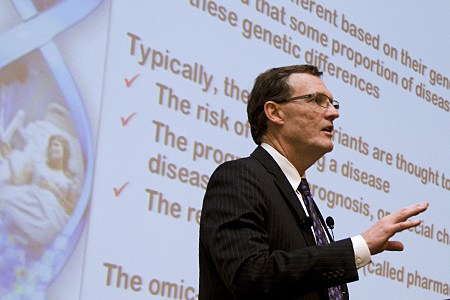Cracking the code of the common cold
Research Day speaker Dr. Stephen Liggett says understanding genomic variation in human rhinoviruses could lead to personalized treatments
The keynote speaker for this year’s USF Health Research Day led a team that for the first time mapped out the entire genome of nearly 100 different strains of the common cold virus. The work may provide a powerful tool leading to the first effective treatments for the common cold.
“It had never been done,” said Stephen Liggett, MD, professor of medicine and physiology at the University of Maryland School of Medicine and director of its Cardiopulmonary Genomics Program. “We started off by defining the strains of common cold virus by DNA and built a family tree” showing the evolutionary relationship between strains.

Dr. Stephen Liggett delivered the Roy H. Behnke Distinguished Lecture
as keynote speaker for the 2012 USF Health Research Day.
The analysis of Dr. Liggett’s University of Maryland team, working with colleagues at the University of Wisconsin-Madison, received widespread coverage when published in the journal Science in 2009.
While it does not attract the widespread attention of illnesses like heart disease and cancer, the common cold affects billions of people worldwide yearly and can be particularly debilitating for the very young and older individuals. This viral infection is responsible for half of all asthma attacks, and the common cold and related complications in asthmatics are estimated to cost $60 billion yearly in the United States, Dr. Liggett said. “It’s a major public health problem.”
The researchers found that some common cold viruses, also known at the human rhinoviruses, exchange genetic material between two separate strains of virus that infect the same person. Such a swap, known as recombination, was previously not thought possible in human rhinovirus. During cold season, when many different strains of rhinovirus may be causing infections, recombination could rapidly produce new strains.
Dr. Liggett, who has asthma, is particularly interested in identifying the “pro-asthmatic” human rhinovirus strains most likely to lead to complications when the asthmatic person catches a cold. His team found that the strains are organized into about 15 small groups that come from distant ancestors, so a “one drug fits all” approach for beating back the common cold in unlikely.
“It’s more likely that four or five drugs would need to be developed to target specific regions of certain groups,” Dr. Liggett said. “That’s where personalized medicine comes in. The decision about which drug to use would be based on the genetic characteristics of a patient’s specific rhinovirus infection.”
Dr. Liggett continues his work putting together pieces of the human rhinovirus puzzle – combining information from genomic discoveries with clinical data to answer questions like how rhinoviruses mutate as they spread and which are more associated with asthma exacerbations. This can provide clues about how the virus responds to the human environment, which will be important in designing new treatments.
Story by Anne DeLotto Baier, USF Health Communications. Information from a University of Maryland Medical Center news release was used in this article.

